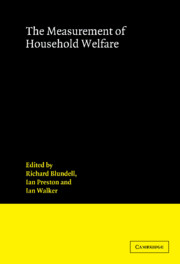Book contents
- Frontmatter
- Contents
- List of contributors
- 1 An introduction to applied welfare analysis
- 2 Measuring the cost of children: a theoretical framework
- 3 The collective approach to household behaviour
- 4 Ordinal and cardinal utility: an integration of the two dimensions of the welfare concept
- 5 The determination of welfare in nonintact families
- 6 Female labour supply, housework and family welfare
- 7 Engel equivalence scales in Sri Lanka: exactness, specification, measurement error
- 8 Measuring the life-cycle consumption costs of children
- 9 Family fortunes in the 1970s and 1980s
- 10 Ethically-consistent welfare prescriptions are reference price-independent
- 11 The effect of systematic misperception of income on the subjective poverty line
- Index of names
- Index of subjects
1 - An introduction to applied welfare analysis
Published online by Cambridge University Press: 13 January 2010
- Frontmatter
- Contents
- List of contributors
- 1 An introduction to applied welfare analysis
- 2 Measuring the cost of children: a theoretical framework
- 3 The collective approach to household behaviour
- 4 Ordinal and cardinal utility: an integration of the two dimensions of the welfare concept
- 5 The determination of welfare in nonintact families
- 6 Female labour supply, housework and family welfare
- 7 Engel equivalence scales in Sri Lanka: exactness, specification, measurement error
- 8 Measuring the life-cycle consumption costs of children
- 9 Family fortunes in the 1970s and 1980s
- 10 Ethically-consistent welfare prescriptions are reference price-independent
- 11 The effect of systematic misperception of income on the subjective poverty line
- Index of names
- Index of subjects
Summary
Introduction
The measurement of individual and household welfare stands out in applied economics for its ability to usefully blend economic theory with empirical practice. It is an area where empirical investigation clearly benefits from theoretical insight and where theoretical concepts are brought alive and appropriately focussed by the discipline of empirical relevance and policy design. There are difficult issues to face in identifying who gains and who loses from complex policy reforms. Potential Pareto improvements are scarce and the scope for useful policy recommendations may well be limited unless one is prepared to go further, attempting to evaluate the sizes of the gains and losses to assess whether, in some sense, the gains outweigh the losses.
A wide variety of empirical work has attempted to measure the impact of policy changes on the behaviour and living standards of individuals. This kind of work has flourished in recent years with the increased availability of large micro datasets and significant decreases in the costs of analysing such data using microeconometric methods. The aim of this book is to complement the existing literature by concentrating on the issues that are highlighted in empirical applications.
Earlier empirical work was based on estimated behavioural models obtained using aggregate data. However, this was limited insofar as it, at least implicitly, imposed the conditions required to be able to infer individual behaviour from aggregate data. Important contributions by Muellbauer (1975, 1976), by Jorgenson, Lau and Stoker (1980) and by Jorgenson (1990), building on the pioneering work of Gorman (1953, 1981) established exact conditions under which it is possible to make such inferences from aggregate data.
- Type
- Chapter
- Information
- The Measurement of Household Welfare , pp. 1 - 50Publisher: Cambridge University PressPrint publication year: 1994
- 5
- Cited by



